These notes are intended to provide a casual sky watcher or someone already into amateur astronomy living in Eastern Australia with a summary of what is happening in the night sky in September 2013. The finder charts have been produced for an observer based on the Gold Coast (Queensland, Australia) but will be useful for observers elsewhere in Eastern Australia.
Instructions on how to obtain customised satellite viewing information for your location can be found here. If you find this page of interest, you may wish to follow this website automatically using Twitter and the sites RSS Feed.
Planets for September 2013
Venus is visible low above the Western horizon as evening twilight ends. Saturn is visible above the Western horizon at the end of evening twilight. Mars and Jupiter are visible low above the North Eastern horizon before morning twilight begins. Neptune is visible all month in the evening sky and Uranus rises just before 7 pm mid-month. Mercury appears above the Western horizon mid-month in the evening twilight. It continues to move higher above the horizon as September draws to a close and reaches maximum elongation from the Sun next month.
Note that to the unaided eye that all planets look like stars. The word planet is A planet (from Ancient Greek ἀστὴρ πλανήτης (astēr planētēs), means “wandering star”). Mercury, Venus, Mars, Saturn and Jupiter are easily visible to the unaided eye. Due to their faintness, Uranus and Neptune will require a a large pair of binoculars and a detailed finder chart to locate (see http://www.skyandtelescope.com/observing/objects/planets/12435011.html).
Individual Sky Events for September 2013
All times AEST unless otherwise stated.
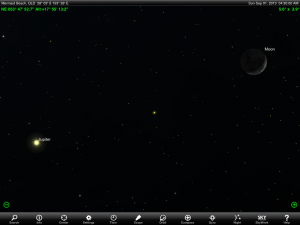
1 September 2013: Waning crescent Moon located to left of Jupiter. Morning pre-dawn sky.
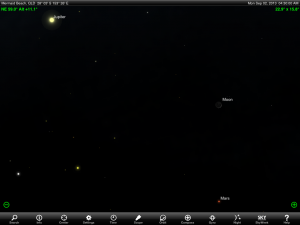
2 September 2013: Slim crescent waning crescent Moon located above Mars. Morning pre-dawn sky.
5 September 2013: 9:36 pm New Moon
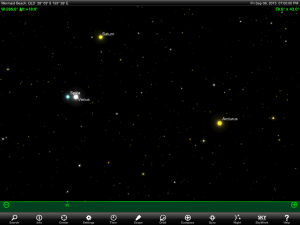
6 September 2013: Venus and Spica (the brightest star in the ancient Greek constellation Virgo The Virgin) close in the early evening sky.
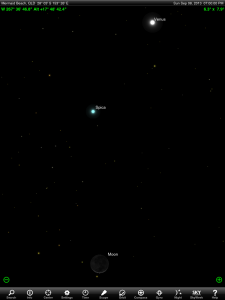
8 September 2013: Waxing crescent Moon located below Spica (the brightest star in the ancient Greek constellation Virgo The Virgin)
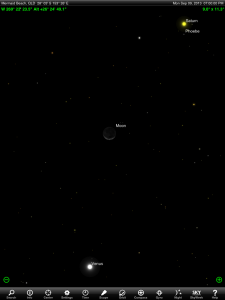
9 September 2013: Slim crescent waxing Moon located between Venus and Saturn. Early evening sky.
10 September 2013: Waxing crescent Moon located above Saturn. Early evening sky.
13 September 2013: 3.08 am First Quarter Moon
14 September 2013: Mercury at descending node
16 September 2013: 3 am Moon at perigee (367,391 km from Earth in it’s orbit)
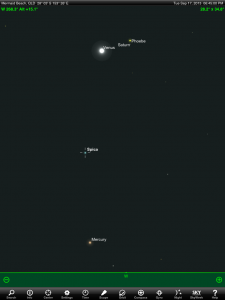
17 September 2013: Look above the Western horizon as evening twilight ends to see Mercury, Venus and Saturn.
19 September 2013: 9:13 pm Full Moon
20 September 2013: 3 pm Pluto stationary
21 September 2013: 2 am minor planet 4 Juno stationary
23 September 2013: 7 am Spring Equinox (Southern hemisphere)
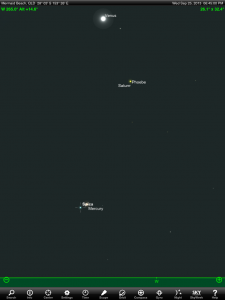
25 September 2013: Mercury and Spica close as evening twilight ends
25 September 2013: Mercury at aphelion
27 September 2013: 1.55 pm Last Quarter Moon
28 September 2013: 4 am Moon at apogee (404,308 km from Earth in it’s orbit)
28 – 29 September 2013: Waning crescent Moon passes above Jupiter. Morning sky.
For Further Information
Customised Astronomy & Satellite Viewing information
Information on how to obtain customised astronomy & satellite viewing information for your location can be found here on this website.
Information About The Finder Charts
Charts accompanying this article have been produced with permission using the highly recommended Sky Safari Pro tablet app. Stars are shown to 5th magnitude. This is a compromise between what would be seen from a dark sky site and the reality that most people live in cities or towns with significant light pollution.
References
The information in this post has been prepared using the following references.
- Astronomy 2013, Quasar Publishing http://www.quasarastronomy.
com.au/ - Sky Safari Pro Ipad app, http://www.southernstars.com/
products/skysafari/index.html - https://en.wikipedia.org/wiki/Planet
Hi Paul, I was just driving home from Civic towards Weston Creek on Sunday night at 20:30 and in the western sky there was a bright star/ planet. So when I got home Dad and I pulled out the binos and downloaded an app to help us figure out what it was, however within minutes the star/ planet disappeared. It was in the vicinity of Venus/ Saturn. Any ideas what it was/ how it disappeared so fast?
William,
Good to hear from you.
Off hand, no bright star leaps out at that time. Spica is the bright star near/below Venus and Saturn but it sets at 8 pm from Canberra. Heavens-Above.com has a good star chart which you can adjust to see if you recognize the star you saw. The link to the chart for Canberra is: http://www.heavens-above.com/skychart.aspx?SL=1&SN=1&lat=-35.28333&lng=149.2167&loc=Canberra&alt=609&tz=AEST
Regards,
Paul Floyd.